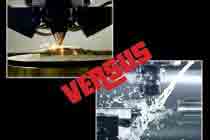Last week our founder and president Gordon Styles was a guest on Leslie Langnau’s MakePartsFast podcast. In the interview he discussed designing for plastic injection molding as well as 3D printed conformal cooling cores. The text below is an excerpt from the podcast.
Process-based part design
Whenever anyone is designing anything they should really consider the manufacturing process they’re designing for. This may sound like a no-brainer but in the rapid prototyping industry so often it’s not the case, especially with new inventors. They come up with an idea for a part and then ask you if you can make it. When you ask them what process they designed it for, they will say “don’t you decide that?”. Well that’s actually not the case. It’s very important that the designer has the process in mind right at the outset when designing a part.
If a designer doesn’t have experience in the field of plastic injection molding, one of the best things they can do is read a book of rules. They explain the basics on how to design for plastic injection molding.
One of the big problems with plastic injection molding arises when a part has very long deep hollows and the core has to get all the way down to the bottom and it has to extract all that energy out of the molding. When such a part has been molded it’s hot. It’s got to freeze off, the part has to freeze off plastic. You then have to cool it off, extract enough energy from it, so you can extract the part from the tool.
3D Conformal Cooling
Traditionally these cores that go very deep get very hot and they have to be cooled. The way they used to do it was drilling holes one way and then drilling holes the other way. Then they would block off the holes in certain places to make the coolant go around in a rectangular pattern. That’s very inefficient. So now, you can 3D print these cores with what look like wormholes very close to the surface of the core. That allows you to extract the energy very efficiently. When you’re able to print these cores you can save up to 30% of the cycle time. That can save a lot of money and dramatically reduce cost of production.
Once you’ve got conformal cooling core technology you can do a lot of other things. One of the biggest problems with molding is that when you inject the plastic, as it flows out into the part, when you’re trying to make holes in the part, when the plastic meets the metal that will form that hole in the plastic, it has to go around it and recombine on the other side. Where it recombines we call that a weld area. It will leave what looks like a scratch on the surface of the plastic. These weld marks can cause problems. They can be stress-cracking areas or if the part’s supposed to seal and not let gas or some kind of liquid out it can leak at those points. Not to mention the fact that it looks unsightly. It just looks like a part scratch at the edge of every single hole.
With conformal cooling cores it means that you can cycle the tool. That means you can heat it up, inject, and the material will flow in very easily around the obstruction creating the hole and you get minimal, or in some cases no, weld marks. Then you switch on the cooling water and you cool the part very quickly. You go through this heating and cooling cycling mode. This will allow you to get much better looking parts and you’re able to make the material flow much further in the tool so there’s less need for sequential gating tools.
Chris Williams is the Content Editor at Michigan CNC Machining Parts, Inc.. He is passionate about writing and about developments in science, manufacturing and related technologies. He is also a certified English grammar snob.




